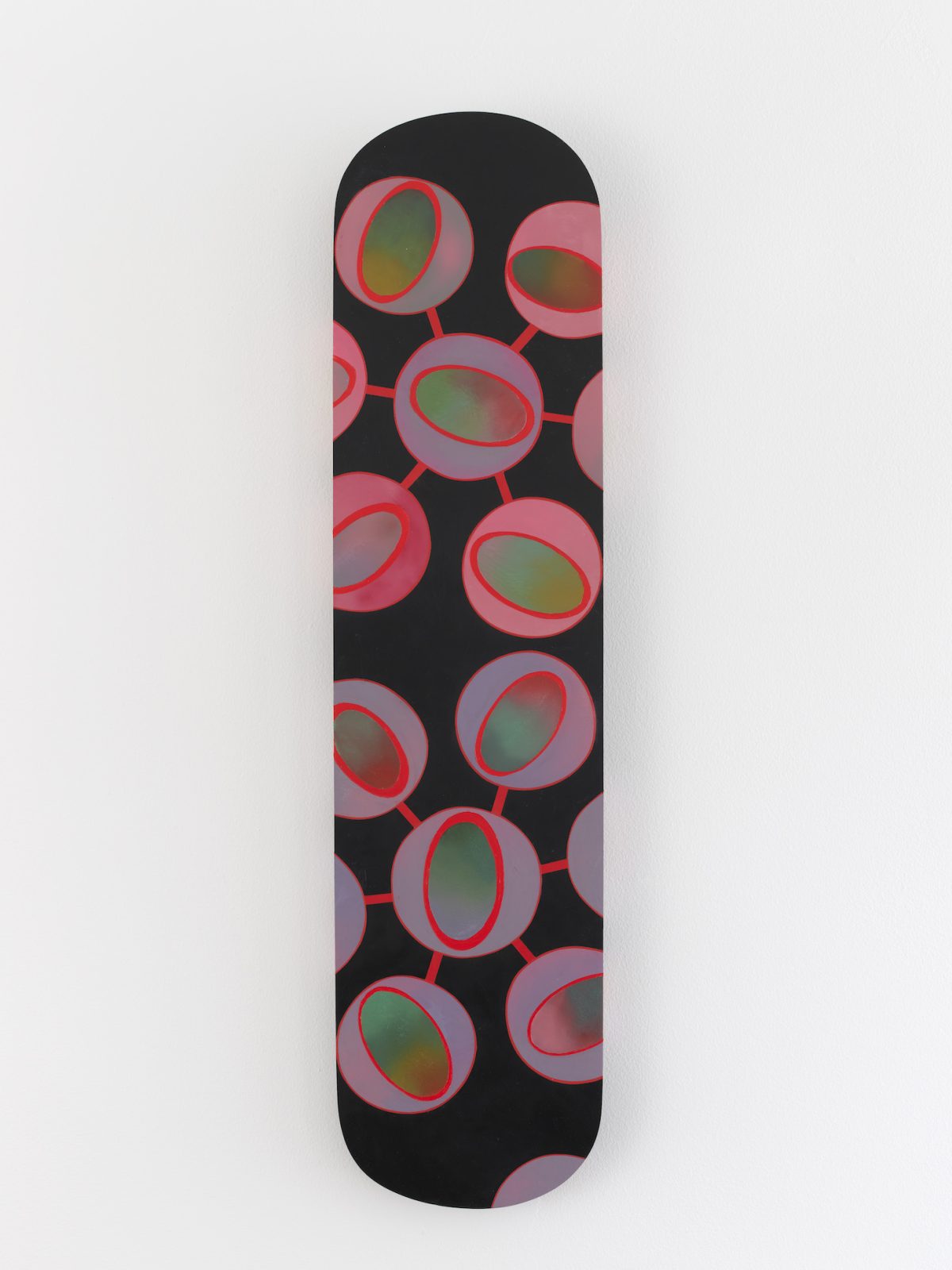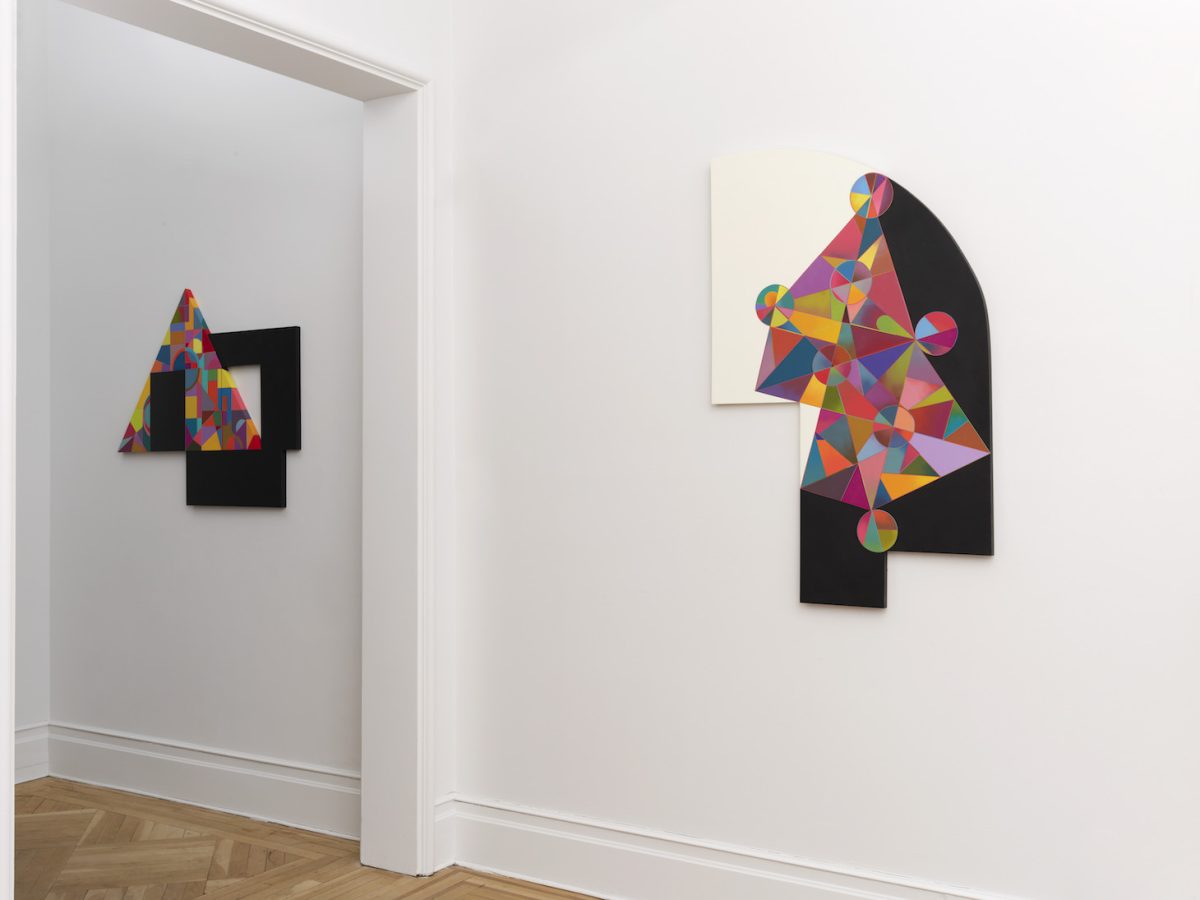
I first reviewed Marilyn Lerner’s art in 1989 and have been following her career ever since. Over the past three decades, she has expanded her geometric vocabulary, while staying true to it. That vocabulary, which draws inspiration from Hilma af Klint (whose work was first shown in New York at PS1 in 1989), game boards, tantric art, and Indonesian music, as well as the saturated colors found in traditional Indonesian dance costumes, has slowly but continuously changed.
In her current exhibition of eight paintings, Marilyn Lerner: Walking Backward Running Forward – Again, at Kate Werble Gallery (March 11–May 13, 2021), the most recent incremental changes will be apparent to those who know Lerner’s work. (According to the gallery press release, while all the paintings are dated 2021, they were started three years ago.)
The biggest single change that has taken place in Lerner’s work since I began following it is that she has moved from a graphic to an optical geometry, which has little to do with the tradition that includes Josef Albers, Julian Stanczak, and Richard Anuskiewicz. Rather, she has opened up a potentiality that is all her own.
I would describe that potentiality as a shifting, asymmetrical kaleidoscopic hum in which a myriad of geometric forms and multiple hues dance around each other within an overall structure that both is tight and idiosyncratic.

For those who don’t know Lerner’s work, the primary changes are most evident in “Queen Bee” and “Dido Dreaming of Carthage,” which, like all the exhibition’s paintings, are done in oil on wood panel.
“Dido Dreaming of Carthage” is dominated by two enhanced hexagons placed side by side, like twins. Each hexagon consists of a vertical rectangle whose top and bottom are capped by a smaller, squat triangle and a larger, equilateral one, respectively.
The painting is defined by the identically proportioned geometric structures anchored at the bottom by the larger triangles. Eight circles line the edges of each structure: three on each side and one at the top and bottom.
The outer halves of the three circles along the hexagons’ interior sides overlap, forming vertical ellipses, as well as determining the space between the two hexagons. That space is equal to the space separating the hexagons’ outer edges from the painting’s right and left edges. Meanwhile, the circles at the apex and nadir of each hexagon help to hold the structures in place within the painting’s rectangle.

There is an eccentric but tight logic to these paired, overlapping structures, which Lerner divides further, into what I estimate to be more than 200 distinct sections, each of them a unique hue, following no obvious pattern.
Additionally, each of the ground’s 10 separate sections is a different density of violet, magenta, and pink. By modifying the color, Lerner breaks down the hierarchy between figure and ground.
While these ground hues dominate the painting, especially because they are echoed within the hexagons, they do not overwhelm or deny the other colors — including blacks, yellow-greens, bold oranges, solid reds, and various blues, some of which are shaded.
The result is mesmerizing in different ways. There is the overall hum of the dominant hues, which Lerner offsets and interrupts with other colors. We are pulled into the painting, as we constantly refocus: on Lerner’s intuitive placement of color, or the changing configurations, such as a diamond within a diamond in both hexagons. We might notice the interaction of color and form in the three interior circles connecting the hexagons. Some of the shapes are edged by a thin line of color, resulting in a kind of halation. Some of the lines change color as they run between two geometric shapes. Repetition and difference overlap, with neither dominating.

This means that while some of the larger interior structures are repeated in the hexagons, the colors don’t recur according to any deducible pattern; the hexagons are identical structures whose smaller interior divisions and colors do not mirror each other. And that unlikely balance (or is it tension?) is what is apt to hold the viewers’ attention and keep us looking.
Lerner paints one small circle in a clearly defined, monochrome section of each hexagon. An orange circle in the left hexagon is located in a yellow-orange section near the bottom of the painting, while a purple one is in a blue-turquoise section in the mid-right of the right hexagon. Through this and other strategies, “Dido Dreaming of Carthage” undermines the graphic structural order we associate with Op Art, and replaces it with something quirky. Is one of the hexagons meant to evoke Dido, and the other the city of Carthage? Are the circles meant to designate turrets? The connections are tenuous but not necessarily fanciful.
In the optically related painting “Queen Bee,” Lerner again sets form and color, large divisions and smaller subdivisions, into an asymmetrical, kaleidoscopic relationship in which the viewer can sense internal movement within the stillness of the overall structure.

At times, Lerner’s geometric structures convey an almost figural presence. And while her titles are evocative, I seldom make a strong connection between them and the paintings. If anything, the painting takes over, and the titles’ capacity for adding meaning is speculative, rather than literal.
In the exhibition’s six other paintings, Lerner sets the multicolored structures against a black or black and white ground. The overall formats of four of the paintings are idiosyncratic and include a triangle full of colored sections within and coterminous with an open, partial rectangle, as in “By the Sea.” One of the sections of the black rectangle in this painting can be read either as a solid form and part of the larger black structure or as a hole and part of the triangle.
Never a prolific artist, these paintings mark a new shift in Lerner’s career, which has stood apart from the changing styles and fashions that have dominated the art world’s attention over the past 30 years. It is time that the art world recognizes Lerner and other artists who went their own way, and never tried to join any club that would have them.
Marilyn Lerner: Walking Backward Running Forward – Again continues at Kate Werble Gallery (136 East 73rd Street, second floor, Manhattan) through May 13.
0 Commentaires